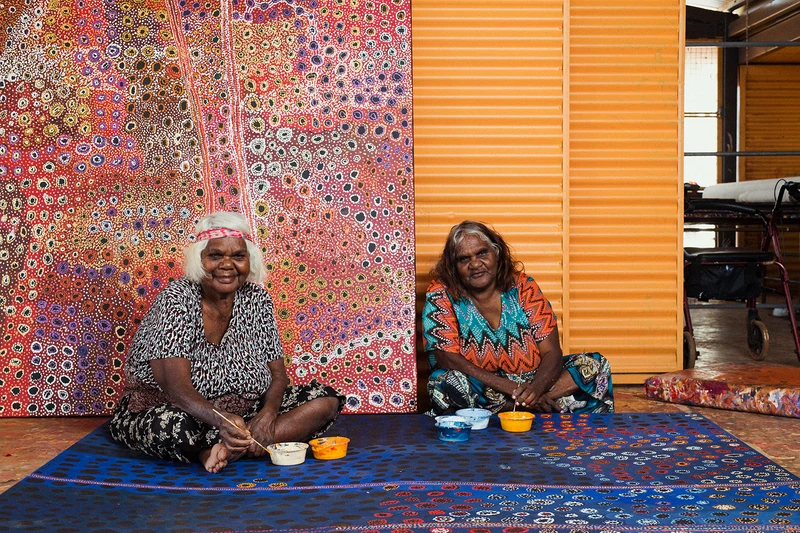Minyma Ninti Pulka: Wise Women
23 Apr-30 May 2025
PV 23 Apr 2025, 6.30-8.30pm


JGM Gallery presents Minyma Ninti Pulka: Wise Women, an exhibition of paintings by ten Indigenous women artists working from Tjala Arts, Amata, on Anangu Pitjantjatjara Yankunytjatjara Lands, South Australia.
A common focus for the exhibiting artists is exploring how best to transmit important cultural knowledge to future generations of Pitjantjatjara, an Indigenous language group whose lands lie in the northwest of South Australia. In this sense, the artists’ work is pedagogic, teaching about ancestral times, survival, animals and landscapes. Many of the artists exhibited in Minyma Ninti Pulka: Wise Women are older, learned women in the Amata community. Their works reflect the abundance of cultural knowledge which the artists continue to preserve and develop. In this context of cultural maintenance, paintings are a mnemonic device which assist in committing landscapes, their features and embedded stories to memory through an array of visual signifiers.
Two predominant stories recur through the exhibited paintings: the Seven Sisters tjukurpa (Dreaming) and kapi tjukula (rock holes). The Seven Sisters tjukurpa not only connects many Indigenous language, social and nation groups across Australia, but also finds parallels in the epistemologies of global cultures. ‘The Seven Sisters’ commonly describe the Pleiades constellation, which is followed across the night sky by its neighbouring constellation, Orion. Kapi tjukula (rock holes), on the other hand, are important sites for the collection of rainwater, a resource which is indispensable in Amata’s desert climate.
For Anangu specifically, the stories of the Seven Sisters and kapi tjukula are related. In a Pitjantjatjara account of the Seven Sisters tjukurpa, the Sisters are told to be running from the wati (bad man) who, through acts of trickery and deception, attempts to catch the Sisters for his pleasure. The wati has power to shapeshift into different landscapes, disguising himself as he pursues the Sisters. A landscape into which the wati transforms himself is one featuring rock formations, such as kapi tjukula. Wise to the tricks of the wati, the eldest of the Seven Sisters protects her younger siblings from him and teaches them to notice and evade his tricks. The Sisters eventually escape the wati because of the eldest sister’s guidance. While this story’s theme of the landscape’s creation is broadly relevant for Anangu law, its others of pursuit and survival, and malign men and spirits are perhaps even more so for Anangu women. The Seven Sisters tjukurpa also strikes up an interesting discourse between places that are important for survival (kapi tjukula) and the sometimes sinister poetry of their creation stories, a conflict between things of value and their weighty connotations.
Art is not only a pedagogic tool for Anangu, but a site of collaboration between different generations of women in their family groups. The exhibiting artists represent the three important artistic families in Amata − the Burtons, the Mitakikis and the Kens − who often work collaboratively. The role of women artists who are teachers to the next generation of painters can be likened to that of the eldest of the Seven Sisters, whose responsibility it was to pass on her knowledge to her younger sisters to ensure their survival. Kumanara (Mona Mitakiki Shepherd) was, before her death in 2023, the oldest painter in Amata, and painted with Tjimpayi Presley and Naomi Kantjuriny under the Mitakiki Women’s Collaborative. All three women shared the same teacher, Kumanara (Tjampawa Katie Kawiny), and learnt their particular style of painting from her. This genealogy of style is shown in Minyma Ninti Pulka: Wise Women through a comparison between Shepherd’s Seven Sisters and Presley and Kantjuriny’s Kapi Tjukula Tjuta (Many Rock Holes). Both paintings are composed of two central vertical passages, surrounded by small, tightly spaced circles representing kapi tjukula. While their titles suggest that these works’ subjects are different, their compositional and representational similarities reinforce the connections of landscape, story, family and style shared between all three artists. Although not originally from Amata, Barbara Mbitjana Moore summarises painting’s importance for intergenerational learning saying, “Through my painting I’m teaching my daughters and grandchildren too. I’m doing this for my family − it’s all about my family.”
Minyma Ninti Pulka: Wise Women is therefore comprised of works that express the importance of women’s roles in Amata, women’s knowledge, and how strong community leadership fosters the preservation of this knowledge. As JGM Gallery Director, Jennifer Guerrini Maraldi says, “Historically, women’s knowledge − particularly Indigenous women’s knowledge − has been sidelined. It is JGM Gallery’s hope to reinstate this knowledge as integral for understanding Indigenous ways of life, and to contribute to amplifying women’s voices from around the globe.”
Minyma Ninti Pulka: Wise Women | Press Release
Download